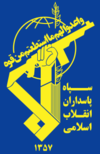Yahya Rahim Safavi
Sardar Yahya Rahim Safavi | |
|---|---|
 | |
| Born | 1952 (age 68–69) Isfahan, Iran |
| Allegiance | Iran |
| Service/ | Islamic Revolutionary Guard Corps |
| Years of service | 1979–present |
| Rank | Major General |
| Commands held | Islamic Revolutionary Guard Corps Ground Forces |
| Battles/wars | Iran–Iraq War War on Terrorism (2001 uprising in Herat) |
| Awards | |
Yahya "Rahim" Safavi (Persian: یحیی (رحیم) صفوی, born 1952) is an Iranian military commander who served as the chief commander of the Islamic Revolutionary Guard Corps.[2][3]
Early life[]
Safavi was born in 1952 in the city of Isfahan, Iran.[2][3] He has Azerbaijani background.[4]
Career[]
Safavi was one of the leaders of the Iran–Iraq War.[5] During the US-led invasion of Afghanistan, he played a key role in the uprising in Herat in November 2001, where American, Iranian and Northern Alliance troops supported a local uprising against the Taliban.
He served as the deputy commander of Islamic Revolutionary Guards Corps until 1997 when he was appointed its commander, replacing Mohsen Rezaee in 1997.[6]
He was replaced as commander of the IRGC by Mohammad Ali Jafari, former director of the Strategic Studies Center of the IRGC on 1 September 2007.[7] Then he was appointed by the Supreme Leader, Ali Khamenei as his special military advisor.[8]
Asset freeze[]
On 24 December 2006, Rahim Safavi was listed in United Nations Security Council Resolution 1737 asking for his assets (among others') to be frozen because of alleged involvements in Iranian nuclear and ballistic missile programmes.[9]
See also[]
References[]
- ^ Poursafa, Mahdi (20 January 2014). گزارش فارس از تاریخچه نشانهای نظامی ایران، از «اقدس» تا «فتح»؛ مدالهایی که بر سینه سرداران ایرانی نشسته است [From "Aghdas" to "Fath": Medals resting on the chest of Iranian Serdars]. Fars News (in Persian). Retrieved 21 October 2014.
- ^ Jump up to: a b "Sayyid Yahya Safavi". tasnimnews.com. 30 January 2019.
- ^ Jump up to: a b "Seyyed Yahya Rahim Safavi". basirat.ir. 30 January 2019.
- ^ "Iran at sea over Azerbaijan". Asia Times. 28 September 2004. Archived from the original on 23 April 2005. Retrieved 31 March 2021.CS1 maint: unfit URL (link) Another ethnic Azeri is Rahim Safavi, the overall commander of the Islamic Revolutionary Guards Corps (IRGC) and the most important military-security official in the country.
- ^ Safavi, Karbala 5 Operation iribnews.ir Retrieved 31 Jan 2019
- ^ Rubin, Michael (Fall 2008). "Iran's Revolutionary Guards - A Rogue Outfit?". Middle East Quarterly. XV (4): 37–48. Retrieved 13 August 2013.
- ^ Sepehri, Vahid (4 September 2007). "Iran: New Commander Takes over Revolutionary Guards". Radio Free Europe. Retrieved 13 August 2013.
- ^ Frederic Wehrey; Jerrold D. Green; Brian Nichiporuk; Alireza Nader; Lydia Hansell; Rasool Nafisi; S. R. Bohandy (2009). "The Rise of the Pasdaran" (PDF). RAND Corporation. Retrieved 20 August 2013.
- ^ "Security Council imposes sanctions on Iran for failure to halt uranium enrichment, unanimously adopting Resolution 1737". United Nations.
| Wikimedia Commons has media related to Yahya Rahim Safavi. |
- 1952 births
- Living people
- Islamic Revolutionary Guard Corps personnel of the Iran–Iraq War
- Islamic Revolutionary Guard Corps major generals
- Recipients of the Order of Fath
- University of Tabriz alumni
- Iranian Shia Muslims
- People from Isfahan Province
- Iranian Azerbaijani militants
